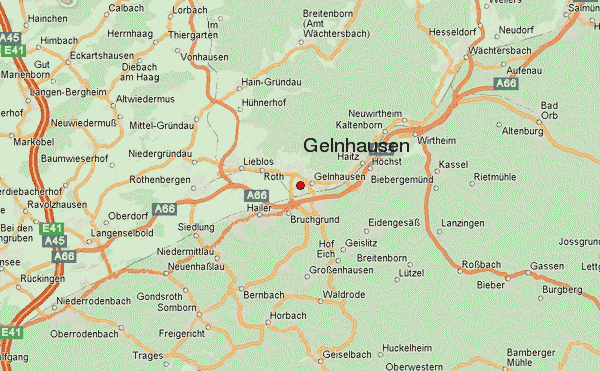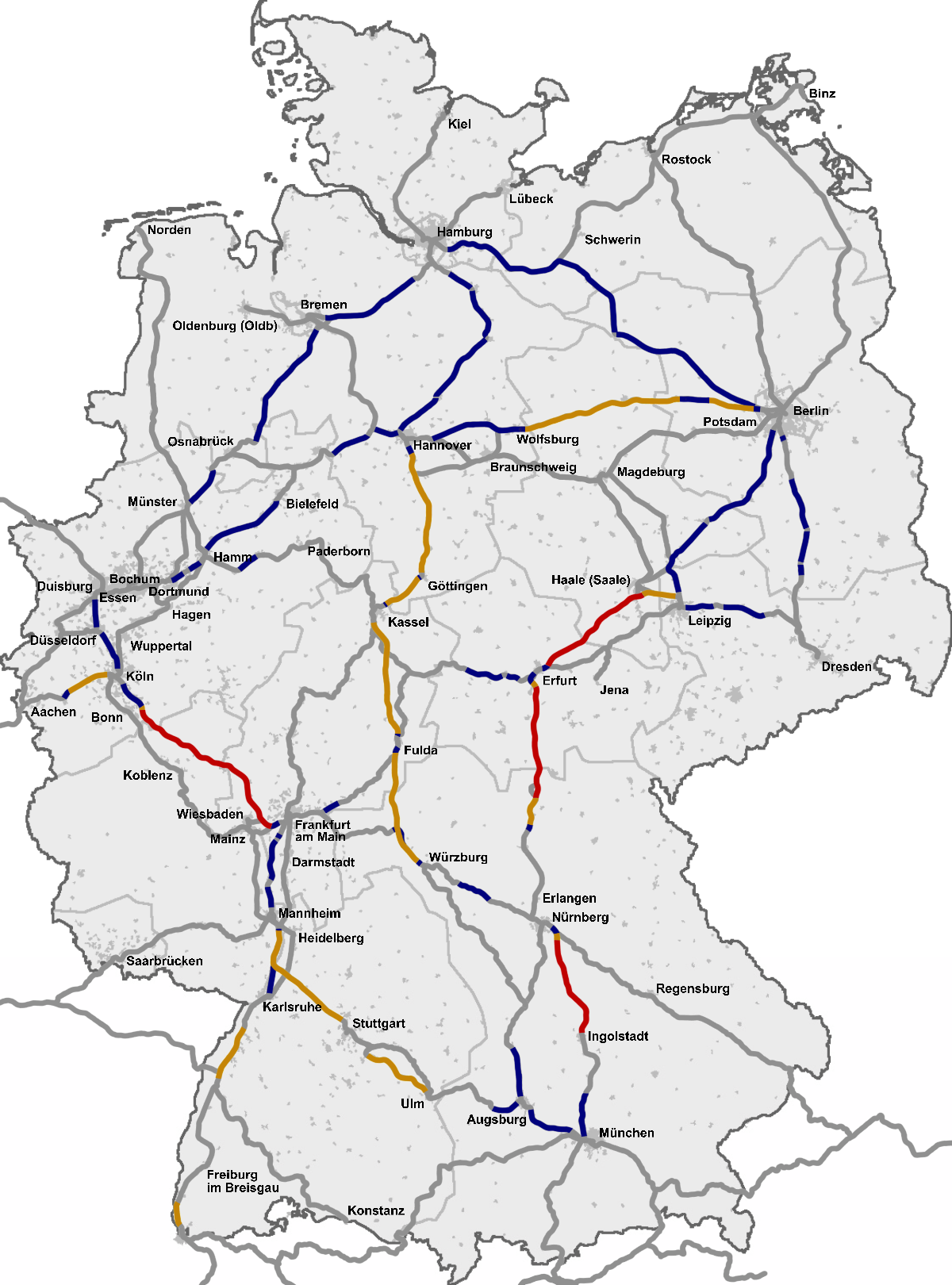Hanau-Gelnhausen high-speed railway
The training and new line Hanau-Würzburg/Fulda-Erfurt is the overall project of a high-speed line, which is being pursued by Deutsche Bahn since reunification in 1990.
Most famous as most controversial part of the high-speed line is the so-called " Mottgers clasp " (also called " North Spessart - route " ) between the Kinzig Valley Railway and the high-speed line Hannover- Würzburg. An agreement is not reached in this case. In order to advance at least the variant neutral extension section between Hanau and Gelnhausen during the Kinzig Valley Railway, which has a separate traffic-related benefits, it should be separated from the overall project and still in 2013 [ deprecated] go into the planning approval.
The aim of the overall project is to remove existing bottlenecks and to create a gap-closure of the North-South highway. In addition to the creation of additional capacity for passenger and freight traffic increasing travel speeds is possible.
The northern Spessart route to be introduced in the Federal Transport Infrastructure Plan 2015 according to the Federal Ministry of Transport. The pre-planning by the German railway runs (October 2013). The project is expected - according to the Federal Ministry of Transport from 2010 - do not go into construction before 2025. The German railway expects to start building not before 2023 (as of January 2013).
The necessary restructuring of the central station Hanau is not part of the project.
Vehicular importance
The project would also like the one between Frankfurt and Würzburg reduce journey times between Frankfurt and Fulda, about ten minutes and increase the utilization of only slightly used in the section between Fulda and the operating station Rohrbach Rail Line Hanover -Würzburg. It would require a further extension of a track extended only in the late 1990s route Hanau- Gelnhausen and continue to the junction with Waechtersbach. Distance between Frankfurt and Fulda would increase by about eight kilometers.
According to a study on the demand plan review of the Federal Transport Infrastructure Plan in November 2010, after the completion of the clasp in the long-distance transport, only the ICE line Frankfurt- Vienna remain on the current path through the Nantenbacher curve in two- hour intervals.
History
Initial planning began in 1991. 's Schedule Mottgers clasp came here instead of the originally planned construction and expansion routes between Hanau, Fulda and Erfurt and between Aschaffenburg and Nantenbach (with connection to the Nantenbacher curve to Würzburg ). In 1992, the German Federal Railroad before first considerations for the lines of a new and upgraded line between Hanau and Erfurt. The ABS / NBS Hanau - Erfurt was received with open styling, as a new project in the Federal Transport Infrastructure Plan 1992.
In May 1999, the DB commissioned an accounting firm to evaluate the project. In addition to the Mottgers clasp Frankfurt also 21, Stuttgart 21 and the new line Rhein / Main Rhein / Neckar were part of the test packet. It was one of 21 two newly starting new projects under the strategy adopted in 1999 net
The new line was filed in May 2000 by the German course for the Federal Transport Infrastructure Plan 2003 and absorbed by the State of Hesse in the national development plan. At a cost of 2.65 billion marks ( Price as of: about 2000 ) the calculated travel time reduction was in long-distance passenger traffic between Frankfurt and Fulda in eight minutes, between Würzburg and Frankfurt in 14 minutes. The course should leave coming in Waechtersbach, east facing and thread it over the top Sinntal at Mottgers running in both directions of the Rail Line Hanover -Würzburg the Kinzig valley train from Hanau.
The state of Hesse laid in 2000 in its National Development Plan already on the Mottgers clasp firmly and consider no longer a design option between Hanau and Fulda.
End of 2000, the rethinking of the Deutsche Bahn. Instead paths to trace out first and then to check their compatibility with the environment, the existing planning should be discarded and develops new pipeline routes from ecological aspects out. In 2000, the German railway launched a space on susceptibility testing. Even before the environmental assessment and route planning should thus be found in ecologically sensitive natural area north Spessart reasonable corridors. A Nuremberg Planning Office was entrusted with the immediate investigation of two scenarios: In addition to a multi-pronged expansion or partial new construction from about Gelnhausen to Fulda ( with the fixed point Schlüchterner tunnel ) in conjunction with section-wise line improvements between Hanau and Nantenbacher curve was as a second alternative, a new building of about Gelnhausen tested for about 25 km east extending Rail Line Hanover -Würzburg. This new route would be north and south of Bad Orb walked past Jossa and should meet the upcoming Hanover new line between Mottgers and castle sense. With each about 1000 m wide strips investigation arose as two examination rooms with a total area of about 670 square kilometers, of which about 70 percent was in Hessen and the rest in Bavaria.
The results were presented in 2002. The study ultimately three possible variant corridors between Gelnhausen, Fulda and the space Jossa emerged. Due to very high to extremely high speeds a development of the existing line between Hanau and Nantenbacher curve was not pursued further. Between Frankfurt and Fulda expansion of the existing line would bring a travel time advantage of eight minutes that Mottgers clasp of nine minutes. Between Frankfurt and Würzburg expansion of the existing line should bring nine minutes, the Mottgers clasp 18
Based on the results of spatial sensitivity study a number of variants of new and upgraded lines between Hanau, Fulda and Würzburg have been developed which differ in styling, design speed and pitch. For design speeds were 160 to 280 km / h and gradient of 12.5, 25 and 40 parts per thousand tested.
One to 2007 by regional and local politicians initially introduced offer to pre- planning costs in the amount of 25 million euros, was not signed by Deutsche Bahn to January 2010. In early 2009 ran first preparations for the introduction of the regional planning process for the project NBS / ABS Hanau- Würzburg / Fulda- Erfurt. In November 2010, Transport Minister Peter Ramsauer expressed in the Transport Committee of the Bundestag Mottgers clasp. The 3.1 - billion - euro project was not even "is planning " and to a construction start before 2025 would not have to think.
The demand plan review 2010 for the projects of the Transport Infrastructure Plan was a four-track expansion of the section Hanau- Gelnhausen 200 km / h and a new line between Gelnhausen - Mottgers for first 250 km / h and later placed 300 km / h basis.
On October 10, 2012, the Federal Ministry of Transport and the DB Netz AG signed a collective agreement on basic evaluation and planning of requirements plan projects. This also included the expansion section Eisenach Erfurt, the four-track expansion between Hanau and Gelnhausen and the Mottgers clasp included.
In January 2013, the German railway and the Hessian Ministry of Transport announced to take further planning and purpose to build an infrastructure project in the following months, which works out the traffic and operational tasks. The municipalities and concerned citizens should be involved early in the planning process. The public participation process should not take place before the state election. The large-scale lines was open. According to the Deutsche Bahn In addition to a new range solution ( Mottgers clasp ) would also be an extension of the sections Hanau Hanau and Fulda -Würzburg considered.
In the first half of 2013 a project structure was adopted. The end of 2013 will take place first information sessions. According to Deutsche Bahn interested parties are fully involved and " maximum transparency " to be created.
One year after resumption of planning the German railway had formed a planning team by its own account and made first traffic forecasts. In addition, preparations had been made for the expansion between Hanau and Gelnhausen.
While the route is provided east of Gelnhausen a large-scale test version and a regional planning process, the section between Hanau and Gelnhausen in each case is to be expanded to four tracks. For this section no regional planning process is provided. The sub-project is to accelerate it.
The German railway does not expect 2023 to the start of construction of the new line.
Financing
The project financing is not secured. It is included in the Federal Transport Infrastructure Plan 2003 with an estimated cost of 3.14 billion euros. However, it was the Federal Railway Infrastructure Development Act ( BSchwAG ) not included in the version dated 27 April 2005. The BSchwAG ( Appendix 1 of § 1, No. 16 ) provides for the right to build a new or upgraded line for the section of Hanau - Nantenbach.
In the investment plan of the federal government for the years 2011 to 2015 in the category D ("Other important projects " ) was added, without implying a commitment to the Mottgers clasp connected in 2012 was the " Erfurt ABS / NBS Hanau - - Würzburg / Fulda " would be.










